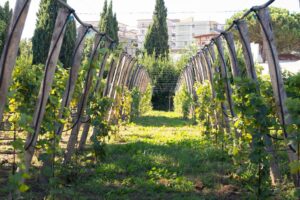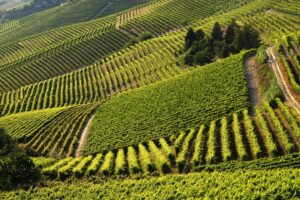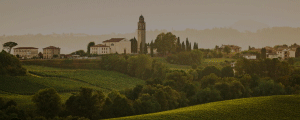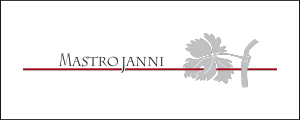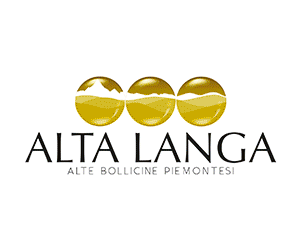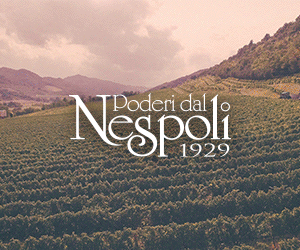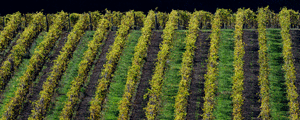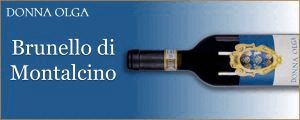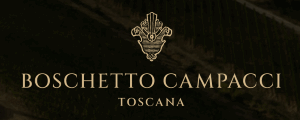Italy’s 2007 grape harvest may be the earliest in the past 30 years and with a decline in quantity of about 5% compared to the 50 million hectoliters that were calculated by ISTAT in 2006.
These are the predictions that have recently been made by the Italian Wine Union (UIV) and ISMEA, after a study of the state of Italian vineyards at the beginning of July. The next few weeks, however, will be fundamental for the outcome both quality-wise and, above all, in determining the grape to wine yield because of the extreme sensitivity of vineyards to meteorological variations in this period.
It is also necessary to verify eventual damage caused by weather conditions in the North in mid July:
“The 3-4 degree rise in temperatures, registered in the second half of March and in April” – explained UIV and ISMEA experts – “caused vines to germinate an average 15 days ahead of the usual harvest period. This situation has not only remained stable, but has been intensified during successive flowering phases that have moved it ahead by 20 days, confirmed substantially in the fruit-set.
This is what appears to be the general situation of Italian vineyards, but it is important to remember that in some areas, above all in the south, they have had a less anomalous season in meteorological terms, so earliness is less evident than in northern regions”. The alarm due to the lack of precipitation, during most of the winter months and during a large part of spring, has subsided thanks to rains in June that re-established the water reserves for vineyards. In June, as well, there was also a lowering of temperatures that slowed somewhat the vegetative stage, which was sped up again by the heat in July. According to the experts, if things continue like this, the harvest could even be anticipated by 4 or 5 days from that of 2003, which until now held first place for “earliness” due to the extremely hot summer that year. Apart from this, however, the 2007 harvest will present fewer problems than that of 2003 in terms of drought conditions. It is important to emphasize, though, that over the past 10 years, the shortening of the vegetative period of grapes, with consequently earlier harvests, is becoming a structural characteristic linked to the general increase in temperatures.
The 2007 harvest will also be characterized by serious pathogen attacks that have caused damage to production: downy mildew has been particularly ferocious in Sicily and oidio, regardless of numerous treatments, has also appeared. And hail storms have also caused damage in some areas.
Quality predictions, however, are good for this year’s grape harvest (obviously where diseases have been kept under control), though it is still early to predict how good.
At a regional level, in general, predictions are oriented towards a substantial stability in the center-north and a slight fluctuation in the south.
Region by Region Predictions …
Starting with the northern areas of Italy, in the Piedmont region production levels should not be much different from those of 2006. Winter and spring had little precipitation and, above all, there were temperatures that were often well above the norm. But the rains during the month of June, however, helped solve water shortage problems that were the cause of much worry. In the Langhe, for example, the winter drought produced mediocre budding and forecasts are negative. In general, however, the weather conditions in June and the beginning of July – hot days, but never too humid, and cool at night – has slowed somewhat the accelerated maturation rates that had become even 20-25 days ahead of schedule in some areas. Budding was early and fast, and the flowering found a favorable period in the second week of May, but it was during the fruit-set period that meteorological conditions caused sparser grape clusters. There were also two cases of hail storms in Albese (which is the Barolo area), and in Astigiano (Moscato region).
In Lombardy, where quantities appear to be same as, possibly slightly less than last year because the weather patterns were characterized by mild conditions. A June that was not excessively hot and with enough rains, caused vegetative processes to slow down, especially in the Oltrepò Pavese area where all of the phenological stages, from budding to fruit-set, were good. Early dates predicted in Franciacorta, though, where already in the beginning of July Chardonnay grapes were getting close to maturation.
In the Veneto region, harvest quality seems to be excellent, and with only a slight decrease in quantity for those grapes that have ripened earlier than usual. As for water levels, the rains at the beginning of June completely restored deficits. There do not seem to have been any further attacks of downy mildew, and only limited damage has been reported due to oidio attacks. In general, red grapes appear to have longer and sparser bunches, ideal conditions for correct maturation and less susceptible to molds.
The Trentino Alto Adige region has predicted a similar production to that of 2006, with even a slight increase in the province of Bolzano, where all of the vegetative phases went well. There have been only sporadic problems with diseases, which were immediately controlled because of the rains in June.
The hail storms that hit the area appear to have caused minimal damage to vineyards. The overall good health of the grapes is cause to believe that this will be a good year in terms of quality for the area’s wines. In the province of Trento, as well, predictions are optimum after a perfect fruit-set. For general plant health, there are no significant problems. Green pruning has been planned and a general thinning out of grape bunches that are considered excessive or on the tops of vines for varieties that have non compact bunches like Merlot, Marzemino and Teroldego.
According to the first forecasts for the Friuli Venezia Giulia region, production should be similar to that of the previous year, except for a significantly earlier harvest due to the anomalous winter weather conditions. Flowering occurred 25-30 days ahead of schedule. And now with the current weather conditions as well, the harvest may even take place at the beginning of August for grapes destined for sparkling wines. These early grapes, in fact, were already in maturation phase at the end of June. Problems with water shortages, which could have caused a decrease in grape yields were avoided thanks to the abundant rains in June. Rains that, however, caused alarm among operators for eventual gray mold attacks.
Vineyards will be harvested about two or three weeks ahead of time in the Valle d’Aosta region, whose production quality and amount will still be about the same as that of the previous year, regardless of higher than average downy mildew and oidio attacks.
In Liguria, if weather conditions continue to be favorable, a good harvest is expected.
For the Emilia Romagna region, there are no significant changes from that of 2006. There is a slight increase registered in the Lambruschi area and a slight decrease in the hill areas of Romagna. The vegetative state is early throughout the entire region. This year’s weather cycles have favored both the flowering and fruit-set of the majority of grapes, which are foreseen to be above-average in all areas for both red and white grapes.
As for plant health, the limited outbreaks of downy mildew did not provoke significant damages, while more pronounced attacks of oidio were not always possible to keep under control regardless of preventative efforts.
The preoccupation of winemakers, which was primarily aimed towards initially dry conditions that could have compromised yields, has now moved to the risk of gray mildew attacks after persistent rains in the area. Hail storms, as well, hit some areas in the provinces of Forli, Bologna and Ravenna, but overall damage was limited.
Tuscany, which is getting ready for a harvest that will take place 10 to 20 days early, has had good vegetative development throughout all of its phases. The water shortage was relieved by rains in May and June. Grape quantity is set to be about the same as last year, while quality should be good. The occurrences of disease were in fact very low. It is still too early to verify the effects of the heat on early grapes, but there shouldn’t be any problems with the Sangiovese variety.
Production should be stable in the Marche region as well, apart from drought problems that still afflict the region’s vineyards. The maturation of grapes, ahead by about 15 days, could be compromised by the lack of rains which, though they were set to arrive, never actually made it to the region. As for plant health, the only real problem has been with oidio, whose attacks have been above average this year, but no other pathogens have appeared.
In Umbria, the state of vineyards is excellent, even if in Ternano the fruit-set did not result as highly as expected. The particularly mild and dry winter had provoked fears of another 2003, but this was avoided thanks to spring rains which, on the other hand, created ideal conditions for the development of pathogens which have never, however, appeared.
In Lazio, production is expected to be inferior to that of 2006. After a mild winter, spring rains negatively conditioned flowering and fruit-set, rendering grape clusters very sparse. Cryptogam attacks have remained within the norm.
In Abruzzo, the various plant phases have taken place in generally favorable meteorological conditions, apart from certain wine zones. There is a good grape bunch load with a higher percentage of fruit-set thus limiting the phenomenon of pathogens that occur in smaller grape bunches. The plant health of vines and grapes has not been put at risk by mildews, which appeared, and were immediately suppressed, in only a few areas. A presence has been noted, however, of oidio around the end of June, against which integrated methods have been applied.
The high temperatures and the decrease in water resources have had an effect on the perfect development of the grape berries, but the rains at the beginning of July should mitigate the problem somewhat.
In Puglia, where production should not surpass the quantity levels of 2006, the vegetative development was rather good and harvest will be early by about 10 days in both the northern area and that of Salento. The widespread downy mildew attacks, mostly in badly maintained areas, have caused damage to vineyards. While oidio attacks, on the other hand, have been kept under control. At the beginning of summer some areas were hit by hail storms which also caused some damage.
After last year’s abundant harvest, Campania is set to return to an average volume this year. The harvest is expected to be early here as well, with vegetative development that was good or excellent in all of its phases. In June and the beginning of July there were oidio and downy mildew attacks, above average in some areas.
In the Molise region, the state of health of vineyards is good overall. There have been cases of downy mildew attacks and some damage due to hail storms. Regardless, this area expects a slight increase over the past five years. Downy mildew also hit some areas in Basilicata, causing a predicted decrease in production.
Calabria, on the other hand, does not expect much variation from last year. Though the weather cycles were anomalous, they still allowed for a good vegetative development. As for plant health, the situation remained in excellent control.
2007 has not been a good year, however, for Sicily. The early harvest is not as pronounced here as in other regions, ahead of schedule by only about a week. But, after a good budding period, there was a very irregular rainy period that provoked virulent downy mildew attacks in the period between flowering and fruit-set, and which could not all be kept under control. Trapani was the hardest hit province where varieties of Nero d’Avola and Grillo were attacked. International varieties, apart from some Chardonnay vineyards, were not as vulnerable because they were already in a more advanced phase. Recently, there have also been attacks in some areas of central and western Sicily, for now mostly on the leaves, it is possible that grape berries will also be affected. Oidio, instead, has not caused problems due to efficient controls. Though it is too early to quantify the extent of damage caused by downy mildew, it is expected that the island will register a consistent decrease in harvest quantity compared to that of last year. It must also be taken into consideration that the heat wave at the end of June could have caused further stress to vineyards.
The current situation in Sardinia is promising for a good year, both quantity and quality wise. The harvest will be early but not as much as in other regions. The abundant rains in April and May favored vigorous vegetative growth and fruit-set has also been excellent. As for plant health, there have been problems in Oristanese and Ogliastra, where downy mildew attacks (which actually hit the entire island but were mostly kept under control) have caused damage in Cannonau variety vineyards. Overall, plants are in good health. DOCG Vermentino is expected to be excellent.
2006
Production Numbers for Italian Wines (thousands of hectoliters)
Piedmont 3,229
Valle d’Aosta 20
Lombardy 1,081
Trentino Alto Adige 1,159
Veneto 7,208
Friuli Venezia Giulia 1,014
Liguria 77
Emilia Romagna 6,768
Tuscany 2,978
Umbria 1,103
Marche 1,090
Lazio 2,316
Abruzzo 3,233
Molise 376
Campania 2,020
Puglia 7,397
Basilicata 246
Calabria 484
Sicily 6,974
Sardinia 859
Italy 49,631
Source: Istat
The Curiosity - In Franciacorta the harvest will start at the beginning of August…
In the Franciacorta area, this year’s harvest will start at the beginning of August, earlier than almost any other in the history of one of the most important terroir of Italian quality wine. Such an early date is similar to that of 2003 but there are many differences apart from it being early. Below, the comments of the Franciacorta Consortium:
The 2007 harvest can be defined as a beautiful vintage year for Franciacorta. Beautiful for how it has progressively evolved and for the quality of the grape that has developed.
The season began very early but was then characterized by successively balanced climatic conditions which permitted regular vegetative development and which did not have any occurrences of hail or freezes that would have compromised plant health. The rains arrived just at the right moment and in the right amount to guarantee the yields per hectare that have been established by the disciplinary. We can define 2007 as a sunny year and with a harvest that is earlier than previous years.
Another year that was famous for its early harvest was 2003, which had a substantially different development than this one because it began with “normal” seasonal development but was then characterized by very high temperatures and basically non existent rains that caused plants to mature very rapidly.
In Franciacorta, everything is ready to begin a beautiful grape harvest that will make the wines of Franciacorta. And there are all the presuppositions for an extraordinary vintage”.
Copyright © 2000/2024
Contatti: info@winenews.it
Seguici anche su Twitter: @WineNewsIt
Seguici anche su Facebook: @winenewsit
Questo articolo è tratto dall'archivio di WineNews - Tutti i diritti riservati - Copyright © 2000/2024











